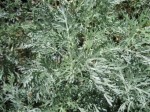 There is nothing new about growing herbs and roses together. Roses were traditionally grown as an important part of the herb garden because of their supposed value for curing a variety of psychological and physical ailments. In addition, the roses and herbs complemented each other with their fragrance and provided contrast in texture and color with their foliage. Many herbs enjoy growing conditions similar to those of roses and are happy to grow in the shade of taller rose bushes.
There is nothing new about growing herbs and roses together. Roses were traditionally grown as an important part of the herb garden because of their supposed value for curing a variety of psychological and physical ailments. In addition, the roses and herbs complemented each other with their fragrance and provided contrast in texture and color with their foliage. Many herbs enjoy growing conditions similar to those of roses and are happy to grow in the shade of taller rose bushes.
Some herbs are more suitable for growing with roses than others. When selecting herbs as rose companions, height, texture, fragrance, foliage and flower color, as well as growing conditions should be considered. Here are five herbs that are especially good companions for old garden roses.
 Rue (Ruta graveolens)
Rue (Ruta graveolens)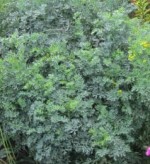
This evergreen perennial native to the Balkans and southeastern Europe, has attractive, divided blue-green leaves that look fabulous with bluish-pink roses.
Height:
-
- 3’
Light:
-
- Full sun
Soil:
-
- Average, well-drained, neutral to slightly alkaline
Hardiness:
-
- Zones 4-11
Outstanding Selections:
- ‘Jackman Blue’,’Blue Curl’
 Sage (Salvia officinalis)
Sage (Salvia officinalis)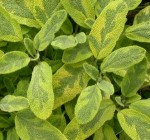
For a nice effect, try one of the sages with golden, purple, or a combination of purple, green and white. Pairing purple sage with ‘Reines de Violettes’ is a knock out. The pebbly texture of the leaves add interest all season.
Height:
-
- 2’
Light:
-
- Full sun
Soil:
-
- Organically rich, well-drained, slightly acid
Hardiness:
-
- Zones 6-9
Outstanding Selections:
- ‘Aurea’ (gold); ‘Icterina’ (yellow-green leaves); ‘Purpurascens’ (purple leaved); ‘Tricolor’ (white, yellow, and green variegated leaves)
 Artemesia (Artemesia spp.)
Artemesia (Artemesia spp.)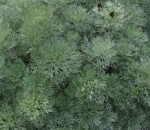
The silvery color and fine texture of several Artemisia’s are especially attractive with the pinks and reds of roses and are useful for separating colors that do not mingle well.
Height:
-
- 10-18”
Light:
-
- Full to part sun
Soil:
-
- average, moist, well-drained
Hardiness:
-
- Zones 3-9 depending on the species and variety
Outstanding Selections:
- ‘Silver Mound’ (1” tall, Zones 3-7; melts out in hot humid weather); ‘Powis Castle’ (18” tall, Zones 4-9).
 Curly Parsley (Petroselinum crispum var. crispum)
Curly Parsley (Petroselinum crispum var. crispum)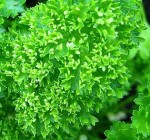
The bright green leaves of this biennial form low mounds that enliven any area and give it a lush appearance. The fine bumpy texture is a pleasant contrast to the smooth leaves and petals of the roses.
Height:
-
- 1-3’
Light:
-
- Full sun to part shade
Soil:
-
- Organically rich, moist, well-drained, slightly acid
Hardiness:
-
- Zones 5-8
Outstanding Selections:
- ‘Forest Green’ (stiff stems); ‘Favorit’ (very curly)
 Golden Marjoram (Origanum vulgare ‘Aureum’)
Golden Marjoram (Origanum vulgare ‘Aureum’)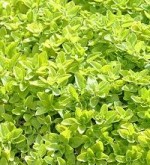
The tiny rounded leaves hug the ground and cover it with gold. Pair it with a rose with golden stamens like Rosa gallica var. officinalis and create a beautiful color echo.
Height:
-
- 1-3’
Light:
-
- Full sun to part shade
Soil:
-
- Poor to average, well drained
Hardiness:
- Zones 5-9
Not all herbs are good companions. Avoid ones like Helichrysum italicum which have a strong fragrance that does not go well with the fragrance of roses. Invasive herbs such as mint and lemon balm can also be a problem. Tall herbs such as rosemary and fennel can overpower the roses unless the roses are very large. Most herbs, however, can enhance the rose garden and are well worth growing there.
